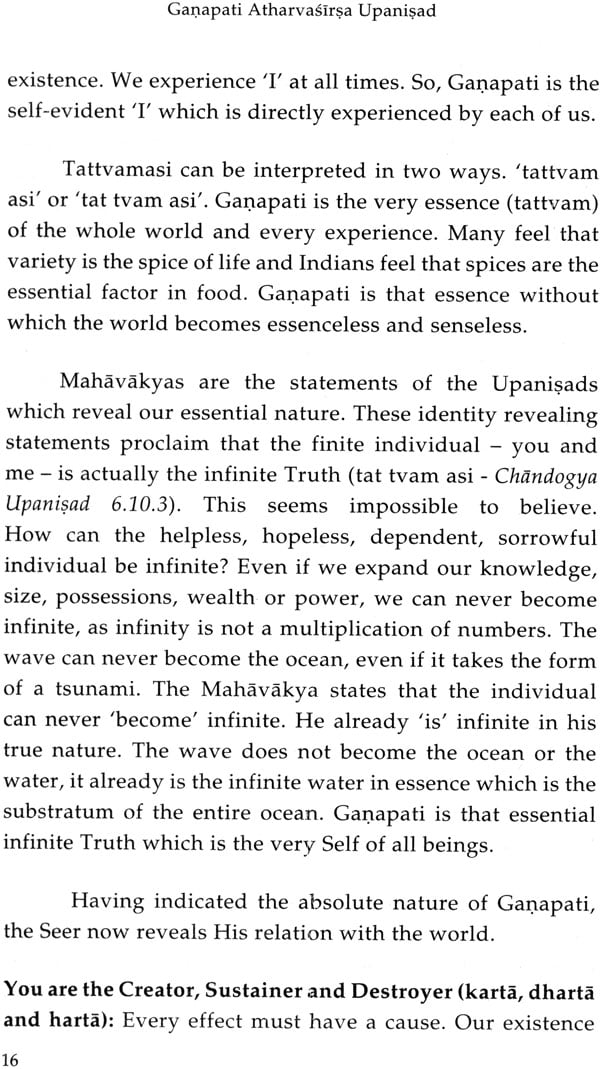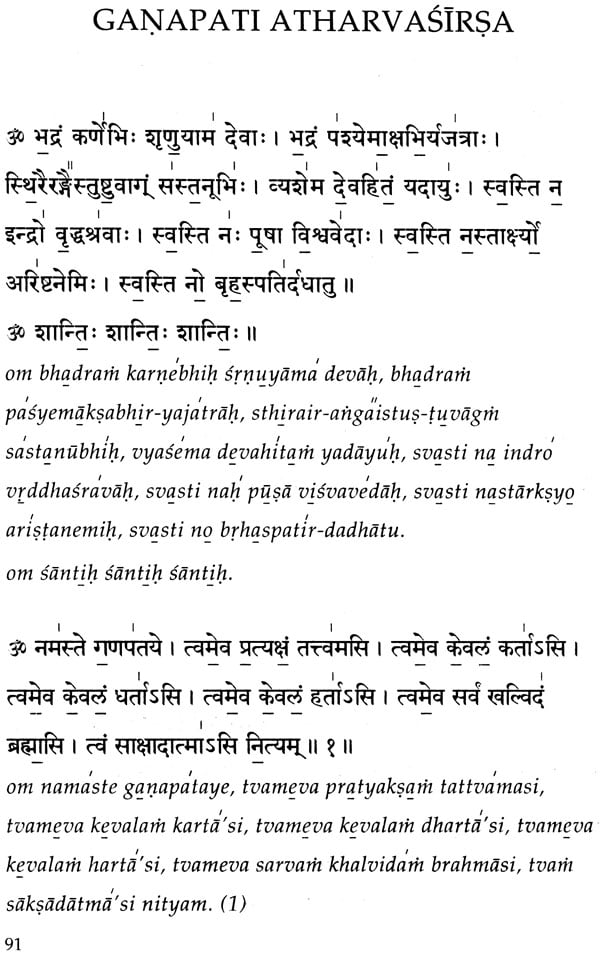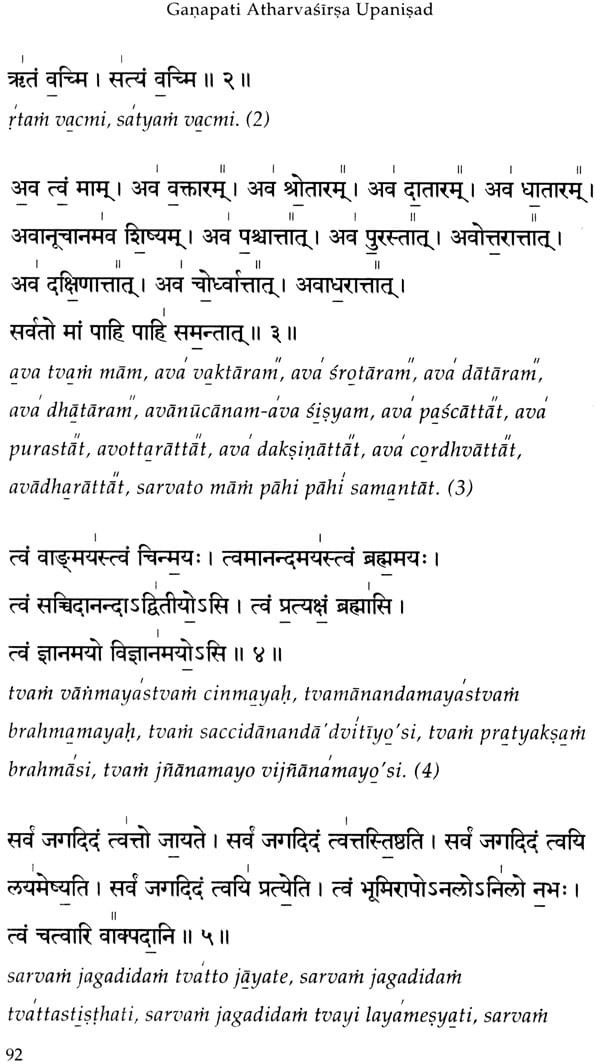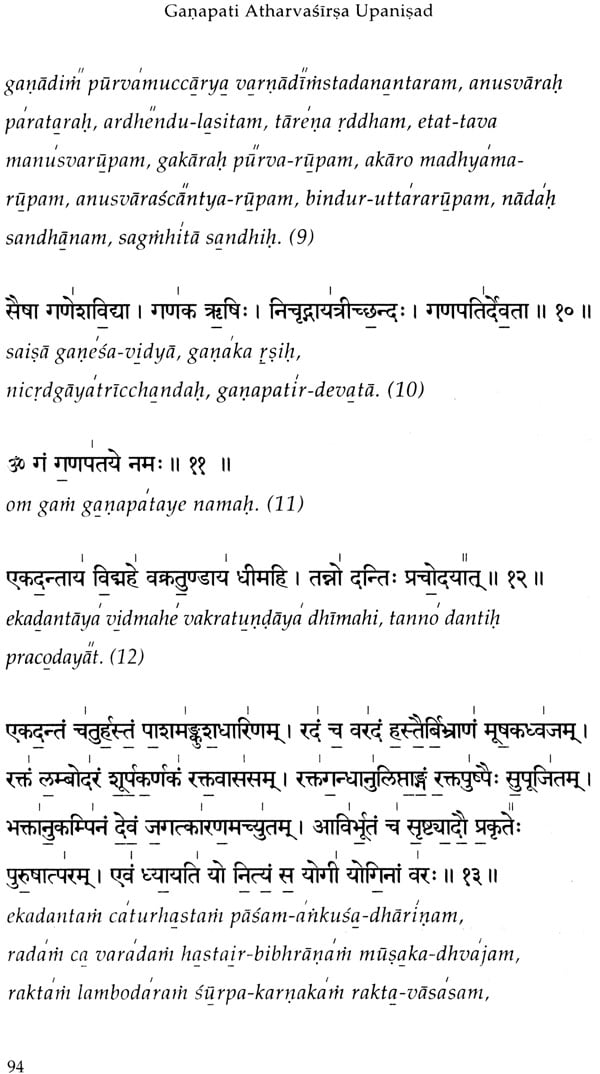
Ganapati Atharvasirsa Upanisad (With CD)
Book Specification
| Item Code: | NAK901 |
| Author: | Swami Tejomayananda |
| Publisher: | Central Chinmaya Mission Trust |
| Language: | Sanskrit Text With Transliteration and Word to Word Meaning English Translation |
| Edition: | 2013 |
| ISBN: | 9788175976009 |
| Pages: | 96 |
| Cover: | Paperback |
| Other Details | 8.0 inch X 5.0 inch |
| Weight | 120 gm |
Book Description
The famous Ganapati Atharvasirsa Upanisad reveals the true nature of everyone’s favourite Lord Ganapati. He is the infinite Truth (Brahman) and the Self of all (Atman).
It also show how the divine form of Ganapati manifests from the bija mantra om gam’. It concludes with enumerating different ways of worshipping Ganapati and the results attained through them (phala sruti).
Swami Tejomayananda’s commentary is easy to read, yet deep in meaning. It inspires the reader to become a life-long devotee of God.
Beauty may lie in the eye of the beholder, but knowledge is true to that which is beheld. True knowledge does not depend on words - a rose known by any name, smells as sweet. It does not change the object or create anything new. For example, my knowledge of the computer does not change its features or recreate it. Knowledge only dispels its ignorance and reveals the object 'as it is'. Any obstruction to this revelation, will distort the knowledge. Hence knowledge should be free of bias, filters, opinions, confusions and vagueness.
Knowledge as thoughts (prama or vrtti-jnana) takes place when the object of knowledge (prameya) is perceived or conceived through the right means (pramana) in the mind of the knower (pramata). For example, the thought 'This is a book' takes place in our mind when we see the book through our eyes. For knowledge of the absolute Truth/Self the mind has to be very subtle, pure and concentrated, as the infinite Truth is subtler than the subtlest. Being so, the Truth cannot be known through perception or conception. It gets revealed through the Vedas.
The Vedas: Veda means knowledge (vid - to know). Vedas are the eternal truths revealed to Seers in the seat of meditation. Since they are not composed, but are revealed, they are called apauruseya sabda pramana (not man-made means of knowledge). They are therefore also considered divine revelations. These were compiled into four volumes (RgVeda, Yajur Veda, Sama Veda and Atharva Veda) by Sri Veda Vyasa and are the main scriptures of the Hindus.
Even though the Vedas mention varied secular subjects, like mathematics (Vedic Maths) and sciences, their main purpose is to give knowledge of that which is beyond human intellection and the scope of human invention - be it in the past, present or future.
The Topics of the Vedas: The main topics of the Vedas are Dharma and Brahma.
(i) Dharma: The constitution gives laws that govern the country. They specify what is constitutional and not constitutional. The laws of the land dictate what is legal and illegal. Building laws do not allow citizens to build in reserve forest land and traffic laws specify parking areas. When not followed, we are penalised. A man was fined for wrong parking. He justified saying that the board read 'Fine for parking', so he thought it was fine to park!
Dharma specifies what is righteous and unrighteous, not just for a particular country or society, but for mankind. It speaks of universal laws that none can escape from. It gives eternal rules that guide our entire life here and hereafter. It specifies what actions give what results, the various realms of experiences that can be attained and how to reach the highest possible standard of living and also its limitations. It elaborates on the means to fulfil our desires and also how to outgrow them.
(ii) Brahma: Vedas give knowledge not only about how to be happy here and hereafter, but also how to liberate ourselves from the here and hereafter. The knowledge of the infinite Truth/Self which liberates man from the bondage of action and the cycle of birth and death is called Brahma- jnana. To attain it is the ultimate goal of human life.
Some claim to want name, fame, money and power. Some seek pleasures and comforts, yet others want love and security. Some want social, political or economical freedom. Every teenager longs to become an adult and get a licence to drive and go wherever he pleases. Some seek knowledge, some search for scientific truths and some work to improve the lot of others. Whatever be their goals, all really only want happiness - maximum possible happiness, that never ends - infinite and eternal happiness. Vedas reveal that eternal and infinite happiness, Brahma, and the means to attain It.
Since Vedas are knowledge of eternal truths, any scripture which reveals them is also considered a Veda. Therefore, even what the Realised Masters teach about the Truth is called Veda. Sri Ramana Maharshi had never formally studied the scriptures, but what he spoke was considered Veda-vakya, the words of the Vedas. In fact, the Realised Masters are the living proof of the knowledge revealed by the Vedas.
(iii) Dharma and Brahma: Human beings are born with three manufacturing defects. They are - a mind full of likes, dislikes, anger and so on (mala), distracted and agitated mind (viksepa) and ignorance of the Truth/Self (ajnana avarana). The Vedas have three main sections - Karma Kanda, Upasana Kanda and Jnana Kanda. By following the rituals, worships and meditations of the first two sections, the mind becomes pure and concentrated and by the study, reflection and meditation of the Jnana Kanda, the supreme Truth/Self is realised. The first two sections constitute the knowledge of Dharma and the last reveals Brahma. Hence, following Dharma prepares the mind for Brahma-jnana which is the ultimate purpose of the Vedas.
Upanisads: Jnana Kanda is also called Vedanta or Upanisad. A simple meaning of the word Upanisad is the knowledge of the Truth that we gain when we go near (approach) the Guru, and sit at his feet in all humility and listen to his words (upa - near or approach, ni - below, sad - sit). It also means the knowledge of the Self which is the nearest to us (upa - samipe), that which is determined through the study and reflection of the scriptures (ni - niscayena) and that which exhausts our vasanas, and dispels the ignorance of the Self (sad - visaranat).
Upanisads as books of knowledge are found within the main body of the four Vedas. Of the 108 known ones, ten of them are considered major as they are commented upon by Sri Adi Sankaracarya, and the rest are called Minor Upanisads.













